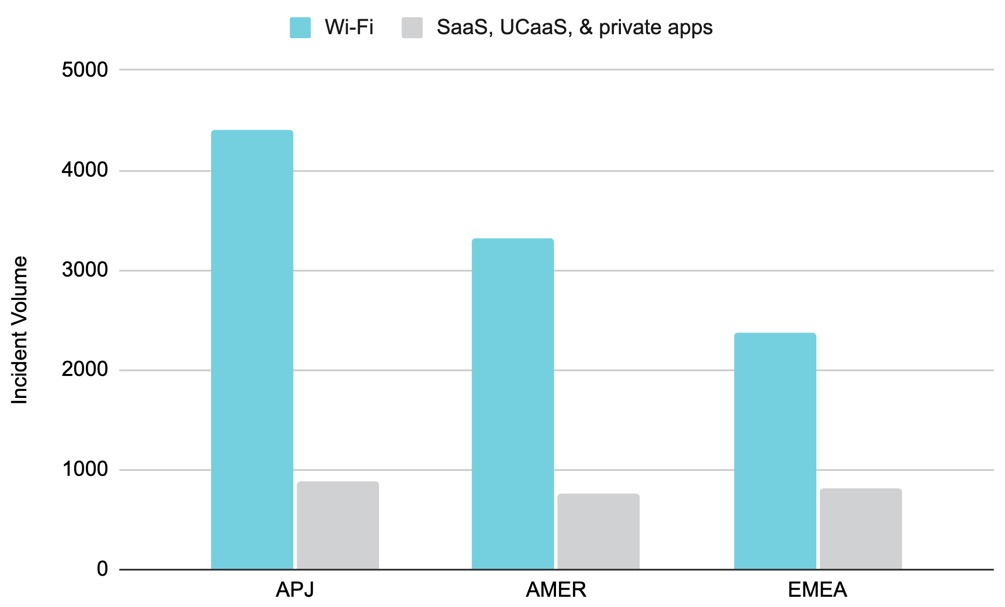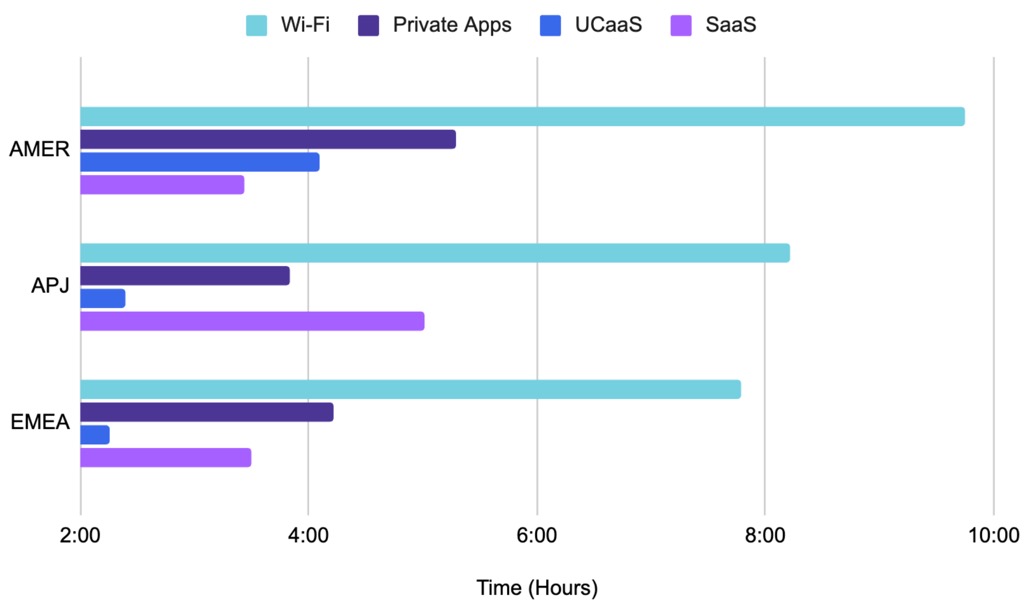
Apr 30, 2024
Problematic in-office wireless connectivity challenges push for return-to-office (RTO)
Networking and IT managers slow to bolster their wireless infrastructure since shelter-in-place rules lapsed have a compelling reason to add it to their to-do lists. An internal analysis of global data from Zscaler Digital Experience (ZDX) indicates that the number-one incident plaguing end-user digital experiences is poor office Wi-Fi, eclipsing the average across all other types of monitored incidents combined by over four times.
From March 1 through April 5, 2024, ZDX, an IT tool for monitoring digital experiences to optimize performance and fix issues, observed 10,085 Wi-Fi-related incidents worldwide, with an average duration of eight and a half hours.
Faced with poor quality W-Fi, the options for employees would include moving to a hard-wired connection, which is not always possible, using a personal mobile hotspot, or leaving the office for home or a public access point, which could invite security risks.
Matthew Barrett, Principal Technical Solutions Consultant at Zscaler and research lead, says individual access points are a determining factor behind the Wi-Fi incidents. “When issues recur on the same APs over and over, we can at the very least infer that many organizations did not prepare hardware for back-to-office.”
Among the roughly 10,000 Wi-Fi incidents detected across nearly a thousand organizations between March 1 and April 5, 2024, 40% of the access points were involved in more than one incident, and 10% were involved in 10 or more incidents.
The Asia-Pacific region led the world in Wi-Fi incidents, with the Americas between third-place Europe, the Middle East, Asia, and Africa—notably, Wi-Fi accounts for 80% of all incidents observed worldwide compared to applications.
Ubiquitous broadband a ubiquitous problem

ZDX registers incidents as a drop in user experience after first correlating the cause to network performance or application degradation. To qualify as a Wi-Fi incident requires ten or more devices in a trusted location (e.g., office, data center, etc.) connecting to corporate Wi-Fi experiencing degraded service due to a combination of decreased signal strength, increased latency (delay in a data packet’s arrival to a destination), packet loss (when data packets fail to arrive at their destination), and gateway jitter (delay variation between received data packets).
In the Americas, the average duration of a wireless connectivity incident was nearly 10 hours until it was either reestablished or improved to expected service levels.
Wi-Fi disruptions take up to a full work day, especially in the Americas

“Complaints about slow or unstable Wi-Fi are so common that they are often overlooked due to a combination of nebulous reporting and a seemingly infinite number of variables. Identifying problematic APs offers a foundational starting point to help isolate the root cause of these issues and get them addressed," said Barrett.
The causes of these incidents are not ISP outages but issues specific to trusted wireless local area networks that employees connect to to access corporate systems and assets. These can include outdated hardware like access points (APs)—for instance, some APs based on aging protocols like 802.11ac and others on 802.11ax. The latter standard offers faster speeds and can be more flexible and compatible with older devices since it uses both the 2.4 GHz and the 5 GHz frequency bands rather than being limited to 2.4 GHz.
Inactive APs on a mesh, misconfigured access points, outdated software, high bandwidth consumption, or simply not powerful enough signal transmission are also factors that can cause dead zones or, weaken signal strength and increase latency.
Zoom and Microsoft Teams, widely credited with enabling remote work en masse in the last four years, are used heavily in office environments today, even if offices remain empty a few days a week or operate at a lower continuous capacity. Achieving a predictable bandwidth consumption baseline for any office is an imperfect science in the new normal.
If your employees are struggling with wireless performance problems at the office, your network team should carry out the following steps:
- Ensure your network operates efficiently and securely with 802.11ax and 802.11ac by confirming compatibility and updating devices with the latest firmware and drivers.
- Optimize router or access point settings, including channel width, channel selection, transmit power, and quality of service (QoS).
- Use Wi-Fi analyzers or network scanners to pinpoint the source of problems. Each environment is unique and dynamic, so determining the root cause can lead you to a fix that may or may not involve access points. With ZDX, you can, among many things, correlate granular information such as ZDX Score variation through an access point and the factors contributing to the score, like average signal strength of users using the access point, packet loss, and maximum and average latency.
Hybrid workers at the office blend face-to-face and digital social interaction and collaboration. Today, many experience unpredictable in-person contact at offices, more so where workers choose their schedule, or there needs to be a (followed) policy in place. Hence, delivering a modern, high-quality digital experience is critical. Suppose corporate locations are to see traffic anywhere near pre-pandemic levels. In that case, CIOs should prioritize seamless, secure, and always-on wireless connectivity in the office to better compete with homes and cafes.
What to read next
Detect Employee Wi-Fi Issues Using Zscaler Digital Experience Monitoring
The employee experience is digital and measurable: how do you score?
Recommended
